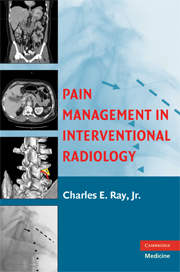Book contents
- Frontmatter
- Contents
- Contributors
- Preface
- Acknowledgments
- 1 Pain Management in Interventional Radiology: An Introduction
- 2 Clinical Evaluation of Low-Back Pain
- PART I LOCOREGIONAL PAIN CONTROL
- PART II SYSTEMIC PAIN CONTROL
- 16 Sedation and Analgesia Medications
- 17 Guidelines for Sedation Administered by Nonanesthesiologists
- 18 Pediatric Sedation for Radiological Imaging Studies and Interventions
- 19 Nontraditional Pain Management in Interventional Radiology
- 20 Postprocedural Pain Control
- Index
- References
17 - Guidelines for Sedation Administered by Nonanesthesiologists
from PART II - SYSTEMIC PAIN CONTROL
Published online by Cambridge University Press: 04 September 2009
- Frontmatter
- Contents
- Contributors
- Preface
- Acknowledgments
- 1 Pain Management in Interventional Radiology: An Introduction
- 2 Clinical Evaluation of Low-Back Pain
- PART I LOCOREGIONAL PAIN CONTROL
- PART II SYSTEMIC PAIN CONTROL
- 16 Sedation and Analgesia Medications
- 17 Guidelines for Sedation Administered by Nonanesthesiologists
- 18 Pediatric Sedation for Radiological Imaging Studies and Interventions
- 19 Nontraditional Pain Management in Interventional Radiology
- 20 Postprocedural Pain Control
- Index
- References
Summary
The purpose of sedation during interventional procedures is to alleviate pain and anxiety. Administration of sedation makes performance of interventional procedures possible in young children and uncooperative adults. Anesthesiologists are trained to administer and monitor all levels of sedation. However, it is a common practice for nonanesthesiologists to administer sedation in a variety of hospital and office settings.
Sedation is a continuum of decreasing levels of consciousness ranging from anxiolysis to general anesthesia. During anxiolysis, also known as minimal sedation, the patient's level of anxiety is decreased; they are responsive to all external stimuli and maintain all protective reflexes. These patients may have some impairment of their cognitive functions. Moderate sedation is a medically controlled state of depressed consciousness in which patients respond purposefully to verbal and tactile stimuli and maintain all protective refluxes. In deep sedation, the level of consciousness is further depressed where patients only respond to painful stimuli. These patients generally maintain their respiratory drive and cardiovascular functions but their gag reflex may be depressed intermittently. General anesthesia involves medically induced complete loss of consciousness from which patients cannot be aroused by any form of external stimuli. These patients lose all protective refluxes and their respiratory and cardiovascular functions are depressed. In most clinical settings, nonanesthesiologists administer and monitor moderate sedation (where not otherwise specified, the word sedation implies moderate sedation in this chapter).
- Type
- Chapter
- Information
- Pain Management in Interventional Radiology , pp. 260 - 267Publisher: Cambridge University PressPrint publication year: 2008



